Tuesday Nov. 14, 2006
Quiz #3 was returned today, after a week's delay. Be sure to
carefully check the grading.
The Expt. #2 revised reports, and the Expt. #3 & #4 reports have
all been graded. There are still several Expt.
#4 reports that haven't been turned in and many of the sets of
materials haven't been returned. The revised Expt. #3 and #4
reports will be due in two weeks, that is on Tuesday Nov. 28.
Most of the 1S1P Assignment #2 reports have been graded. You can
check the grading status and
can check this list to see if you
have earned 45 pts yet on the 1S1P reports. 1S1P Assignment #3 reports are due Thursday
this week and next Tuesday.
You should now be reading Chapter 10 (Thunderstorms, tornadoes, and
lightning) in the text.
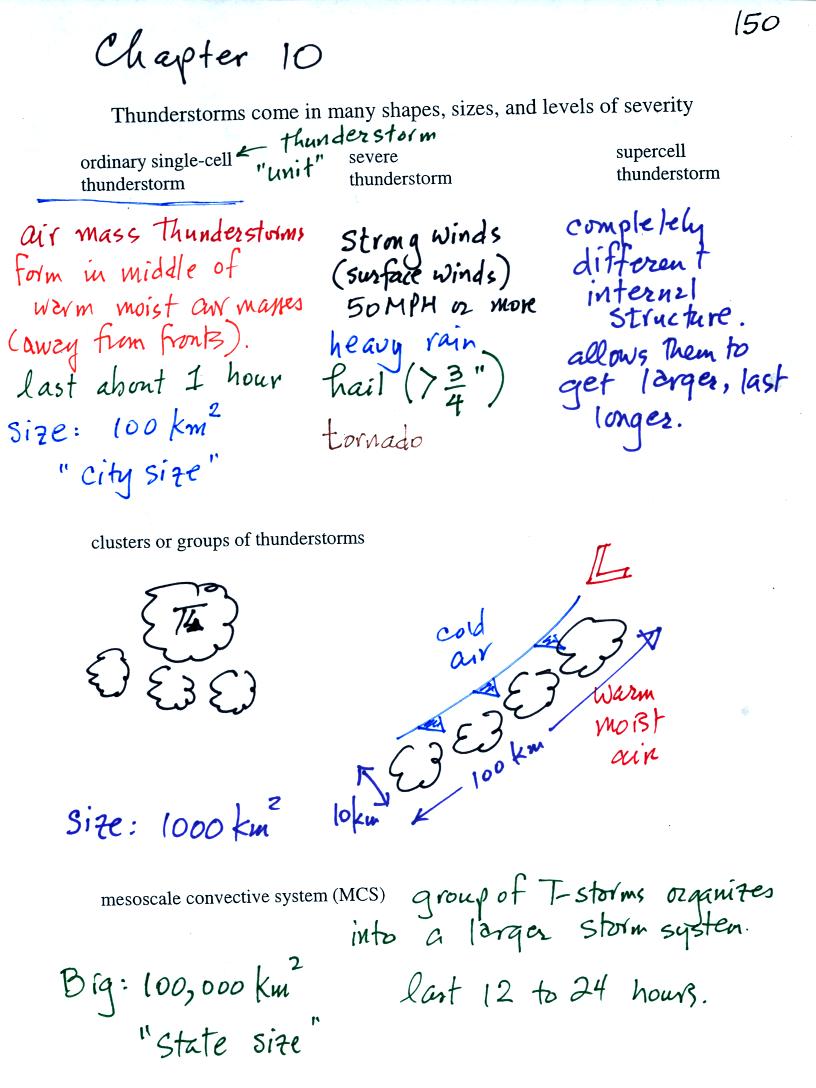
Some general information on different types of
thunderstorms. We will mostly be concerned with ordinary
single-cell thunderstorms
(also referred to as air mass thunderstorms).
The following two figures are a little involved. We will take the
time and effort to try to understand this material so that we can
better appreciated a time lapse video of thunderstorm development.
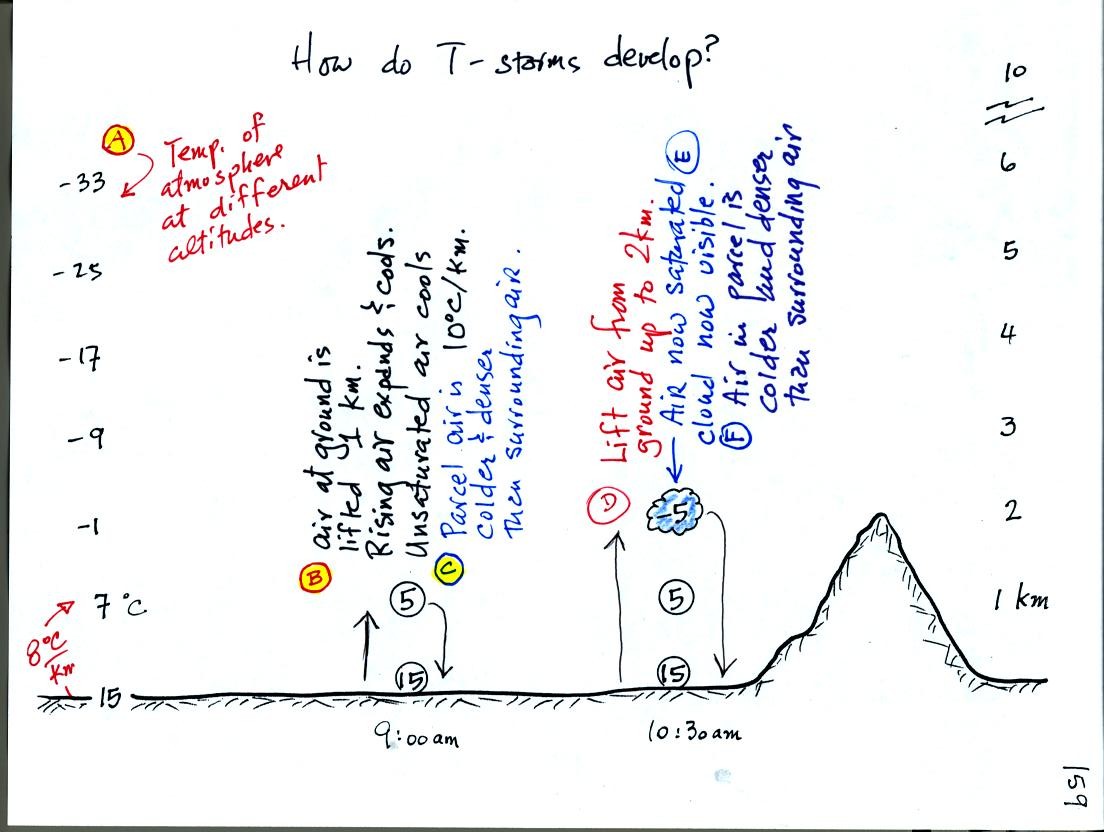
Refer back and forth between the lettered points in the
figure
above and the commentary below.
The numbers in Column A
show the temperature of the air in the atmosphere at various altitudes
above the ground (note the altitude scale on the right edge of the
figure). On this particular day the air temperature was
decreasing at a rate of 8 C per kilometer. This rate of decrease
is referred to as the environmental lapse rate. Temperature could
decrease more quickly than shown here or less rapidly.
Temperature in the atmosphere can increase with increasing altitude
(temperature inversion).
At Point B, some of
the surface air is put into an imaginary container, a parcel.
Then a meterological process of some kind lifts the air to 1 km
altitude. The rising air will expand and cool as it is
rising. Unsaturated (RH<100%) air cools at a rate of 10 C per
kilometer. So the 15 C surface air will have a temperature of 5 C
when it arrives at 1 km altitude. We assume that energy doesn't
flow back and forth between the air inside and outside the parcel (an
adiabatic process). You might begin to recognize some of these
terms from a 1S1P report on atmospheric stability earlier in the
semester.
At Point C note that
the air inside the parcel is slightly colder than the air outside (5 C
inside versus 7 C outside). The air inside the parcel will be
denser than the air outside and, if released, the parcel will sink back
to the
ground.
By 10:30 am the parcel is being lifted to 2 km as shown at Point D. It is still
cooling 10 C for every kilometer of altitude gain. At 2 km, at Point E the
air has cooled to its dew point temperature and a cloud has
formed. Notice at Point
F, the air in the parcel or in the cloud (-5 C) is still colder
and denser than the surrounding air (-1 C), so the air will sink back
to the ground and the cloud will disappear. Still no thunderstorm
at this point.
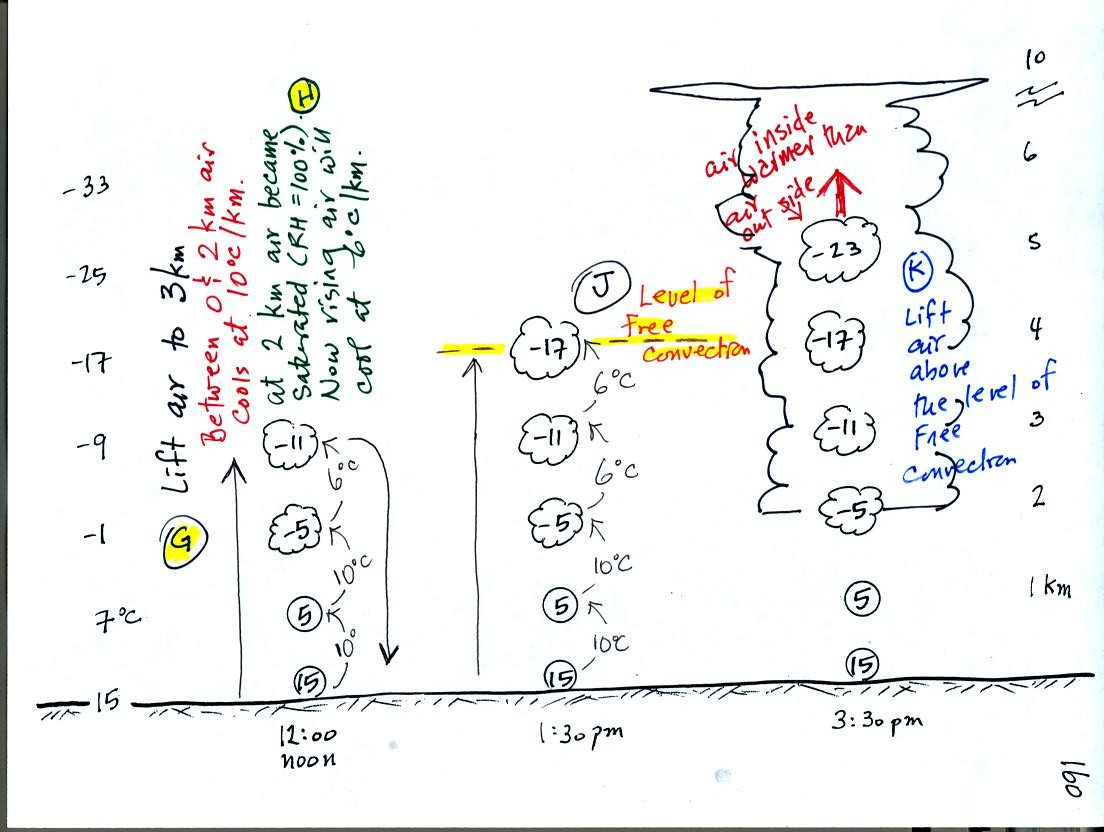
At noon, the air is lifted to 3 km. Notice Point G which shows that
the rising saturated air is cooling more slowly (6 C drop between 2 and
3 km altitude) than the unsaturated air did (release of latent heat
during condensation offsets some of the colling due to
expansion). The air that arrives at 3km, Point H, is again still
colder than the
surrounding air and will sink back down to the surface.
By 1:30 pm the air is getting high enough that it becomes neutrally
bouyant, it has the same temperature and density as the air around it
(-17 C inside and -17 C outside). This is called the level of
free convection, Point J in the figure.
If you can somehow or another lift air above the level of free
convection it will find itself warmer and less dense than the
surrounding air as shown at Point K and will float upward to the top of
the troposphere on its own.
This
behavior was demonsrated in a time lapse video of a developing
thunderstorm. Convective air motions were visible on the tape as
early as 10 am and continued throughout the day. The developing
cloud would rise, stop, and sink. A little later it would get
higher but stop and sink. Finally around mid afternoon it crossed
the level of free convection, continued to move upward, and a
thundersorm quickly developed.
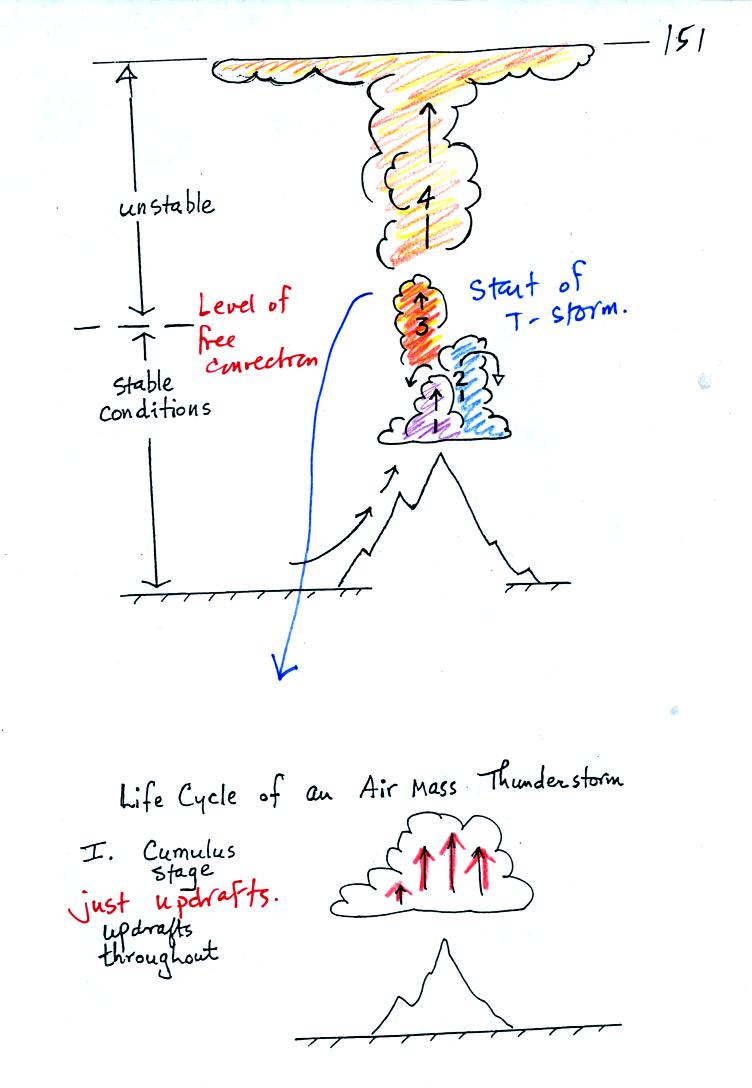
The top portion of this figure repeats what we just
discussed: it takes some effort and often a good part of
the
day before a thunderstorm forms. Early in the day air is lifted
and released. The air finds itself colder and denser than the
surrounding air (Points 1 and 2 above) and sinks back to where it
started from. As the
day goes on the air is lifted higher and higher. If the air is
lifted above the "level of free convection" the air parcel will find
itself warmer and less dense than the surrounding air and will continue
to float upward on its own (Points 3 and 4). This is really the
beginning of a
thunderstorm.
An ordinary single cell
thunderstorm goes through a 3-stage life cycle. In
the first stage, the cumulus stage, you would find updrafts throughout
the inside of the cloud.

Once precipitation has formed and grown to a certain size,
it will
begin to fall and drag air downward with it. This is the
beginning of the
mature stage where you find both an updraft and a downdraft inside the
cloud. The falling precipitation will also pull in dry air from
outside the thunderstorm (this is called entrainment).
Precipitation will mix with this drier air and evaporate. The
evaporation will strengthen the downdraft (the
evaporation cools the air and makes it more dense). The
thunderstorm is strongest in the mature stage.
Eventually the downdraft spreads throughout the inside of the cloud and
interferes with or cuts off the updraft. This marks the beginning
of the end for this thunderstorm. In the dissipating stage you
would find just weak downodrafts throughout the interior of the cloud.
Note how the winds from one thunderstorm can cause a region of
convergence on one side of the original storm and can lead to the
development of new storms. Preexisting winds refers to winds that
were blowing before the thunderstorm formed.
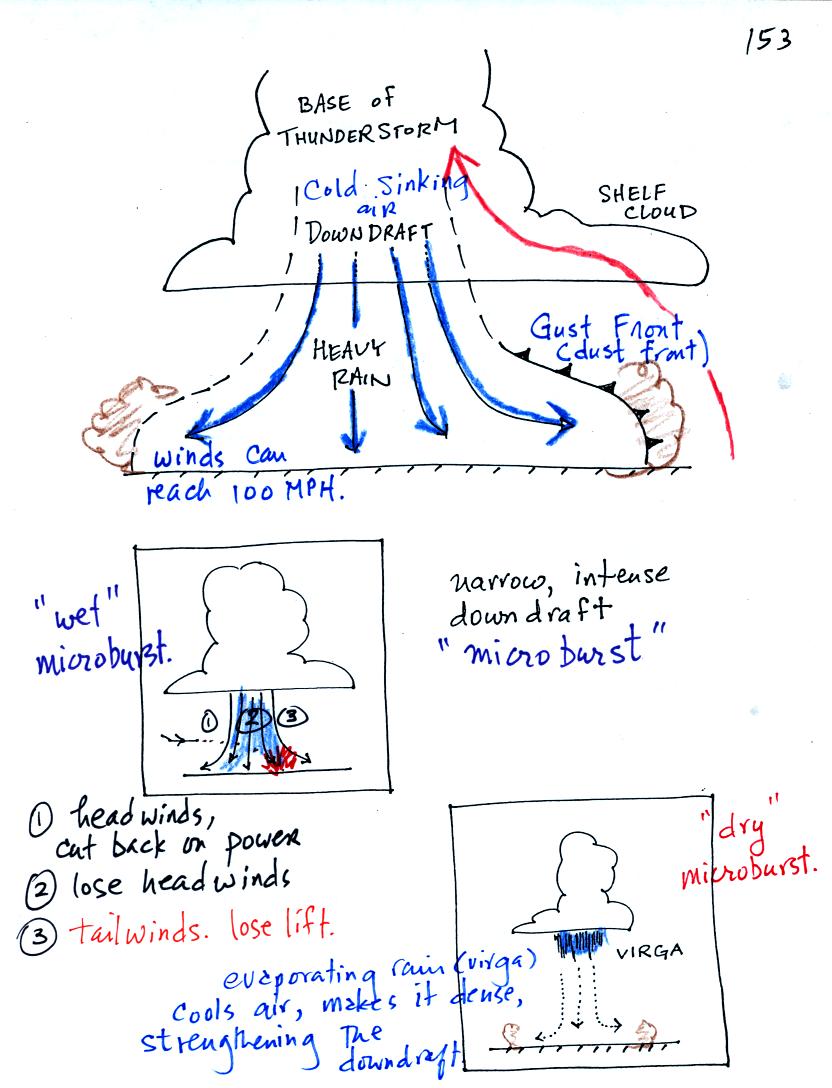
We have talked about most of the features in the top picture
before. The dust storms that thunderstorms stir up can cause a
sudden drop in visibility and are a serious risk to automobile traffic
on the interstate highway.
A narrow intense downdraft is called a microburst. At the ground
microburst winds will sometimes reach 100 MPH (over a limited area);
most tornadoes have winds of 100
MPH or less. Microburst winds can damage homes, uproot trees, and
will blow over a line of electric power poles at some point during our
summer thunderstorm season. Microbursts are
a serious threat to aircraft especially when they are close to the
ground during landing or takeoff (see Fig. 10.10 in the text).
Falling rain could warn of a (wet)
microburst.
In other cases, dangerous (dry) microburst winds might be invisible
(the virga, evaporating rain, will cool the air, make the air more
dense, and the downdraft winds will strengthen).
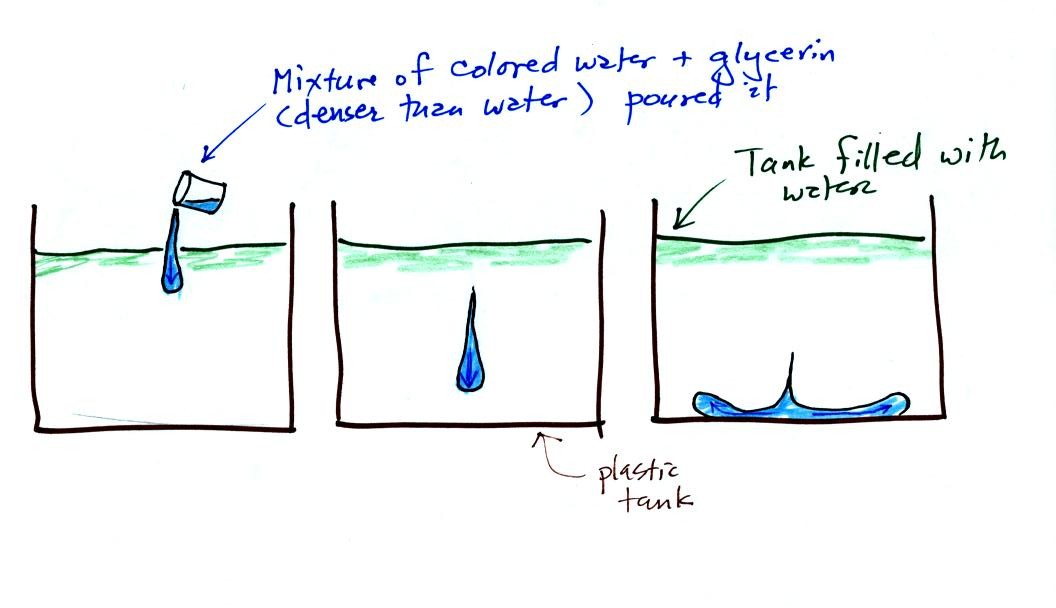
A simple demonstration gives you an idea of what a microburst
might
look like. A large plastic tank was filled with water, the water
represents air in the atmosphere. Then some colored liquid that
is a little denser than water is poured into the tank. This
represents the cold dense air in a thunderstorm downdraft. The
colored liquid sinks to the bottom of the tank and then spreads out
horizontally. In the atmosphere the cold downdraft air hits the
ground and spreads out horizontally. These are the strong
microburst winds that can reach 100 MPH.
The demonstration was followed with a short time lapse video showing a
microburst that occured over the Santa Catalina mountains. Cold
air and rain suddenly fell out of a thunderstorm sank to the ground and
then spread out sideways. The surface winds could well have been
strong enough to blow down a tree or two.
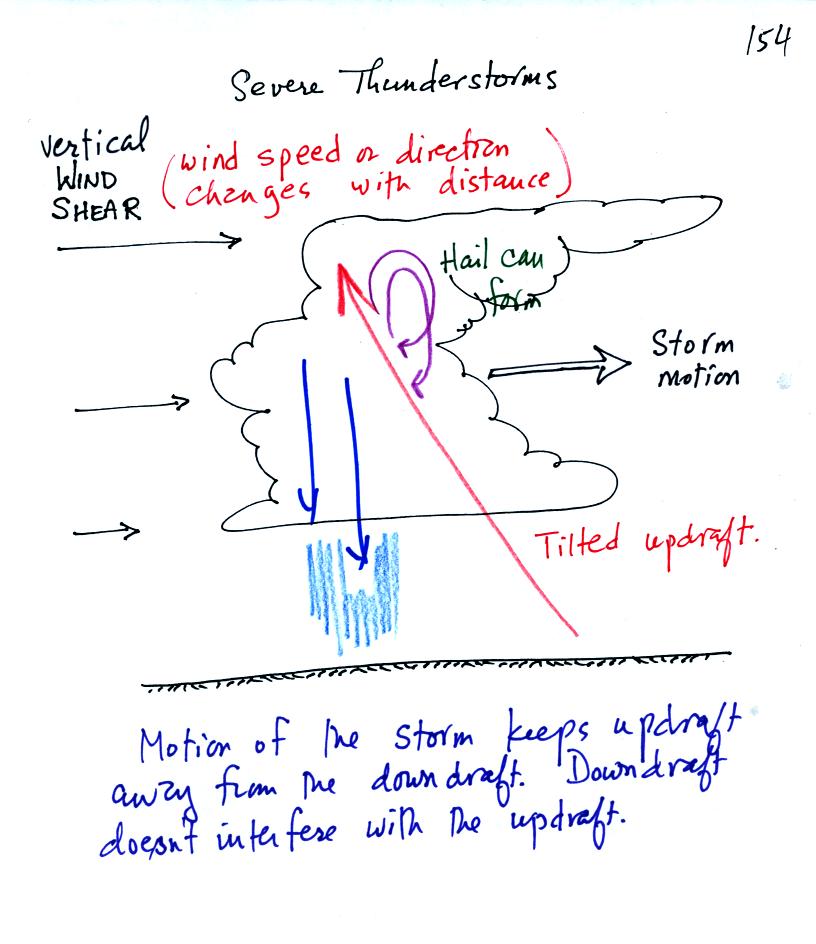
Note how the winds are increasing in speed with increasing
altitude. This is vertical wind shear (changing wind direction
with altitude is also wind shear).
The thunderstorm is moving more quickly to the right than the air
next to the ground. The thunderstorm will move to the right more
rapidly than the air in the thunderstorm updraft which originates at
the ground. Rising air that is situated at the front bottom edge
of the thunderstorm will find itself at the back edge of the storm when
it reaches the top of the cloud. This produces a tilted
updraft.
Remember that an ordinary air mass thunderstorm will begin to dissipate
when the downdraft grows horizontally and cuts off the updraft.
In a severe storm the updraft is continually
moving to the right and staying out of the downdraft's way.
Severe thunderstorms can get bigger, stronger, and last longer than
ordinary air mass thunderstorms. The strong updraft winds can
keep hailstones in the cloud longer which will allow them to grow
larger.
We will find that sometimes the tilted updraft will begin to
rotate. A thunderstorm with a rotating updraft is capable of
producing tornadoes.

This gives some general information about tornadoes.
The United States has more tornadoes than any other country in the
world. This is shown in the figure below.

The central US has just the right mix of meteorological
conditions. In the spring cold air collides with warm moist air
from the Gulf of Mexico to make strong thunderstorms.
Most
tornadoes last only a few minutes and leave a path a few miles long on
the ground. There are of course exceptions. One is
discussed below.
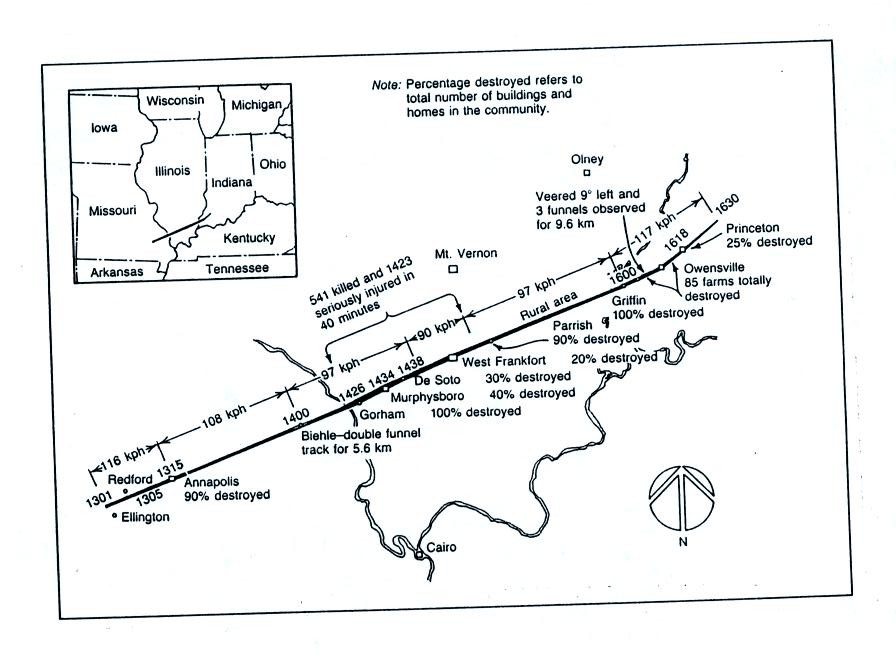
The path of the 1925 "Tri-State Tornado" is shown
above. The
tornado path was 219 miles long, the tornado last about 3.5 hours and
killed 695 people. It is the deadliest single tornado ever.
Most tornadoes move from the SW toward the NE (the motion of
thunderstorms forming along a SW to NE oriented cold front). This
shown clearly in the figure below.
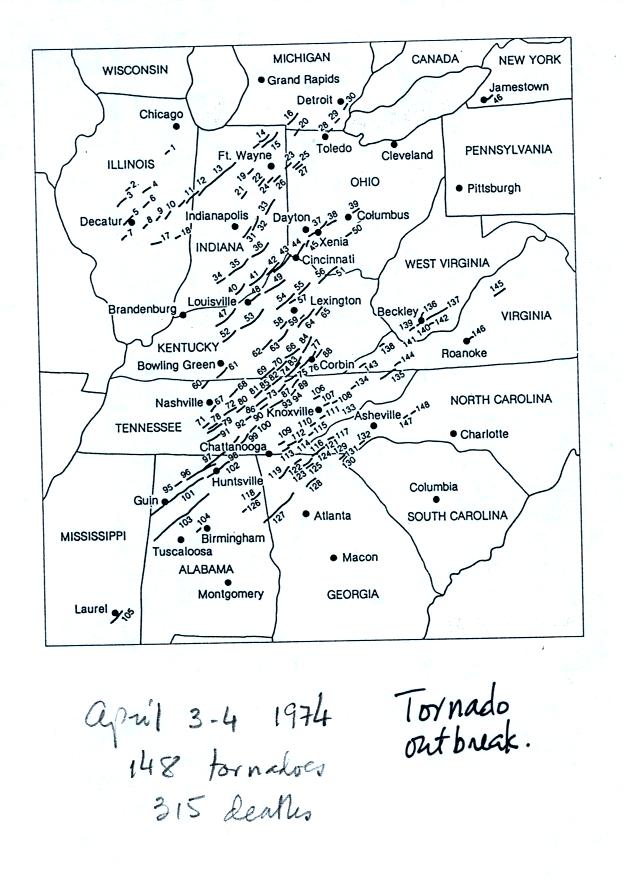
Tornadoes often occur in "outbreaks." Paths of 148
tornadoes
during the April 3-4, 1974 "Jumbo Tornado
Outbreak" are shown above. Note the first tornadoes were located
in the upper left corner of the map. The tornadoes were produced
by thunderstorms forming along a cold front. During this two day
period the front moved from the NW part toward the SE part of the
figure. Note that all the tornado paths have a SE toward NE
orientation.











